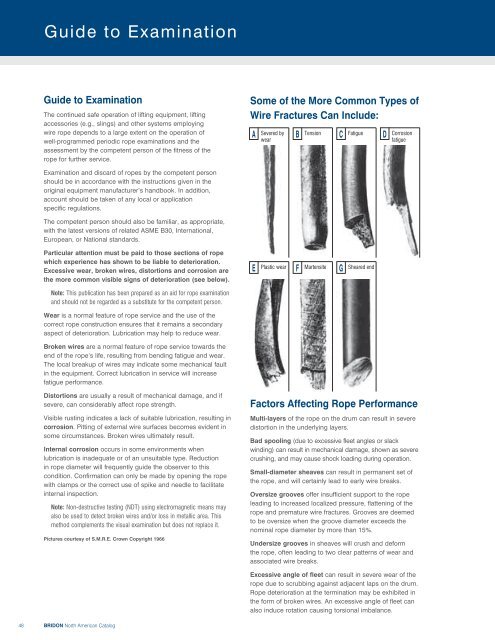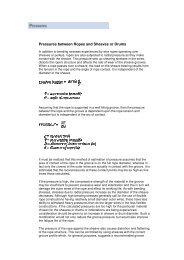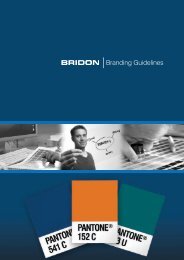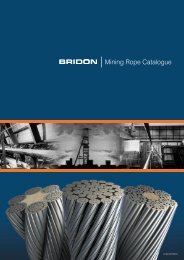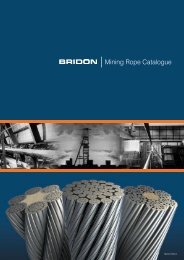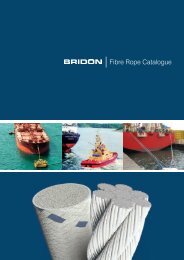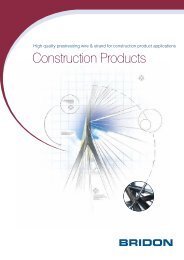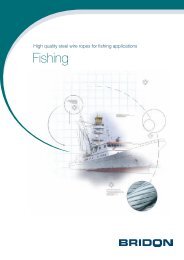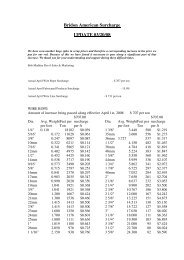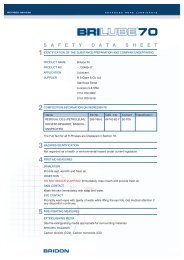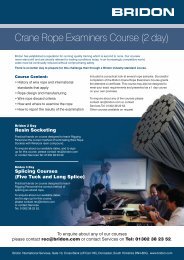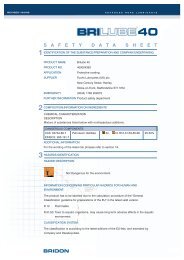Bridon - Teyseer Group
Bridon - Teyseer Group
Bridon - Teyseer Group
Create successful ePaper yourself
Turn your PDF publications into a flip-book with our unique Google optimized e-Paper software.
Guide to Examinationguide to ExaminationThe continued safe operation of lifting equipment, liftingaccessories (e.g., slings) and other systems employingwire rope depends to a large extent on the operation ofwell-programmed periodic rope examinations and theassessment by the competent person of the fitness of therope for further service.Some of the More Common Types ofWire Fractures Can Include:ASevered bywearB Tension C Fatigue D CorrosionfatigueExamination and discard of ropes by the competent personshould be in accordance with the instructions given in theoriginal equipment manufacturer’s handbook. In addition,account should be taken of any local or applicationspecific regulations.The competent person should also be familiar, as appropriate,with the latest versions of related ASME B30, International,European, or National standards.particular attention must be paid to those sections of ropewhich experience has shown to be liable to deterioration.Excessive wear, broken wires, distortions and corrosion arethe more common visible signs of deterioration (see below).Note: This publication has been prepared as an aid for rope examinationand should not be regarded as a substitute for the competent person.Wear is a normal feature of rope service and the use of thecorrect rope construction ensures that it remains a secondaryaspect of deterioration. Lubrication may help to reduce wear.Broken wires are a normal feature of rope service towards theend of the rope’s life, resulting from bending fatigue and wear.The local breakup of wires may indicate some mechanical faultin the equipment. Correct lubrication in service will increasefatigue performance.E Plastic wear F Martensite gSheared endDistortions are usually a result of mechanical damage, and ifsevere, can considerably affect rope strength.Visible rusting indicates a lack of suitable lubrication, resulting incorrosion. Pitting of external wire surfaces becomes evident insome circumstances. Broken wires ultimately result.Internal corrosion occurs in some environments whenlubrication is inadequate or of an unsuitable type. Reductionin rope diameter will frequently guide the observer to thiscondition. Confirmation can only be made by opening the ropewith clamps or the correct use of spike and needle to facilitateinternal inspection.Note: Non-destructive testing (NDT) using electromagnetic means mayalso be used to detect broken wires and/or loss in metallic area. Thismethod complements the visual examination but does not replace it.pictures courtesy of S.M.R.E. Crown Copyright 1966Factors Affecting Rope performanceMulti-layers of the rope on the drum can result in severedistortion in the underlying layers.Bad spooling (due to excessive fleet angles or slackwinding) can result in mechanical damage, shown as severecrushing, and may cause shock loading during operation.Small-diameter sheaves can result in permanent set ofthe rope, and will certainly lead to early wire breaks.Oversize grooves offer insufficient support to the ropeleading to increased localized pressure, flattening of therope and premature wire fractures. Grooves are deemedto be oversize when the groove diameter exceeds thenominal rope diameter by more than 15%.Undersize grooves in sheaves will crush and deformthe rope, often leading to two clear patterns of wear andassociated wire breaks.Excessive angle of fleet can result in severe wear of therope due to scrubbing against adjacent laps on the drum.Rope deterioration at the termination may be exhibited inthe form of broken wires. An excessive angle of fleet canalso induce rotation causing torsional imbalance.48 BRIDON North American Catalog


